#inscribed hebrew and latin
Explore tagged Tumblr posts
Text
another script/language post to go along with my samaritan and aramaic ones. this time, about the coptic language and script:
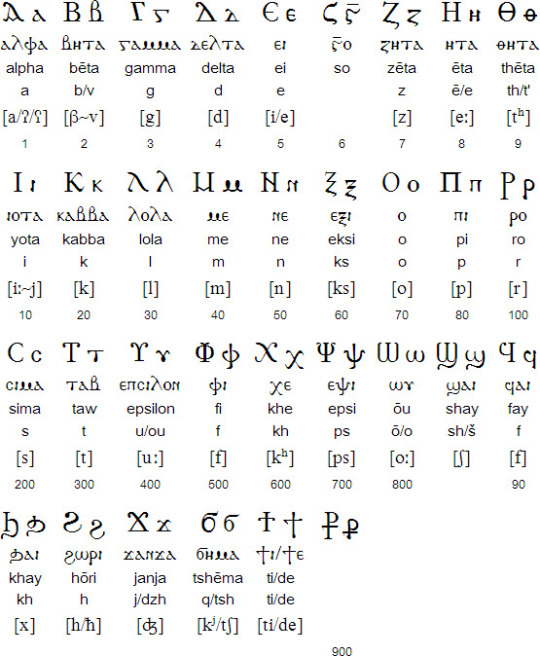
the coptic alphabet is mostly used to write the coptic language, the most recent development of the egyptian language (yes, the one that hieroglyphs were used to write). coptic along with previous iterations of the language belong to the egyptian branch of the afroasiatic family, of which they're the only members. once commonly spoken, coptic is mostly used as a liturgical language by coptic churches today, though copts have started revival movements. the church uses the bohairic dialect of coptic specifically, which has differences in pronunciation and grammar. modern revitalization efforts are also based in this dialect.
coptic has had a notable impact on general arabic and hebrew; for example, timsah - crocodile in arabic and one of the words for crocodile in hebrew (since palestine used to have crocodiles) - comes from coptic "emsah". it's also had a smaller impact on european languages via greek ("barge" and "skete" come from coptic). its biggest impact on a language is its significant impact on egyptian arabic.
the coptic script we have today developed between the 6th century bce and 2nd century ce, when greek was used to transcribe demotic texts. the script is a variation of the greek alphabet with all of its characteristic attributes (alphabet, written left-to-right, contains upper and lower case letters) with influences from demotic (written right-to-left, no cases) which were used to transcribe sounds/letters that aren't in greek (like Ϩ/ϩ, derived from demotic (which is not inscribed in unicode), which is "h"; greek has an "h" sound included in some letters but not just one letter for "h"). you can use coptic to write greek without any new letters to account for sounds, but lower-case coptic letters are just smaller versions of the upper-case ones with no modifications, so coptic and greek speakers may struggle to read the other's alphabet.
like greek, coptic also has its own numerals made from letters. (ⲁ = 1, ⲃ = 2, ⲓ = 10, ⲣ = 100, etc). also like greek, a line is drawn above them to distinguish them from the regular text. a formatted version of this numeral system influenced by arabic was used by egyptians of all religions along with the standard arabic one (and the hebrew one by jews) for a long time.
sample text (article 1 of the universal declaration of human rights in bohairic coptic):
Ⲉ̀ⲫ̀ⲟⲩⲁⲓ ⲥⲉⲙⲓⲥⲓ ⲣⲉⲙϩⲉⲩ ⲛⲉⲙ ⲉⲧϣⲱϣ ⲉ̀ ⲁⲝⲓⲁ ⲛⲉⲙ ⲇⲓⲕⲁⲓⲟⲥⲩⲛⲏ. Ⲛ̀ⲑⲱⲟⲩ ⲥⲉⲉⲣϩ̀ⲙⲟⲧ ⲅⲛⲱⲙⲏ ⲛⲉⲙ ⲥⲩⲛⲏⲇⲏⲥⲓⲥ ⲟⲩⲟϩ ⲙ̀ⲡⲉⲛⲑⲣⲉⲩⲁⲣϣⲏⲧ ⲙ̀ⲙⲉⲧⲣⲱⲙⲓ ϩⲓⲛⲁ ⲛ̀ⲑⲱⲟⲩ ⲙ̀ⲫ̀ⲣⲏϯ ⲛ̀ⲥ̀ⲛⲏⲟⲩ.
transliteration:
Ephouai semisi remheu nem etshōsh e axia nem dikaiosunē. Enthōou se’erehmot gnōmē nem sunēdēsis ouoh empenthreuarshēt em’metrōmi hina enthōou emephrēti enesnēou.
english:
All human beings are born free and equal in dignity and rights. They are endowed with reason and conscience and should act towards one another in a spirit of brotherhood.
a formatted version of coptic script is also sometimes used to write some nubian languages (which are not afroasiatic) like nobiin. the script includes influence from the meroitic script, itself a development of demotic. (one is the letter ⳣ, "w", which comes from this letter.) usage of the coptic script for these languages was more common historically to write old nubian. most nubian languages use arabic or latin scripts today.
the nubian script adapted for nobiin:
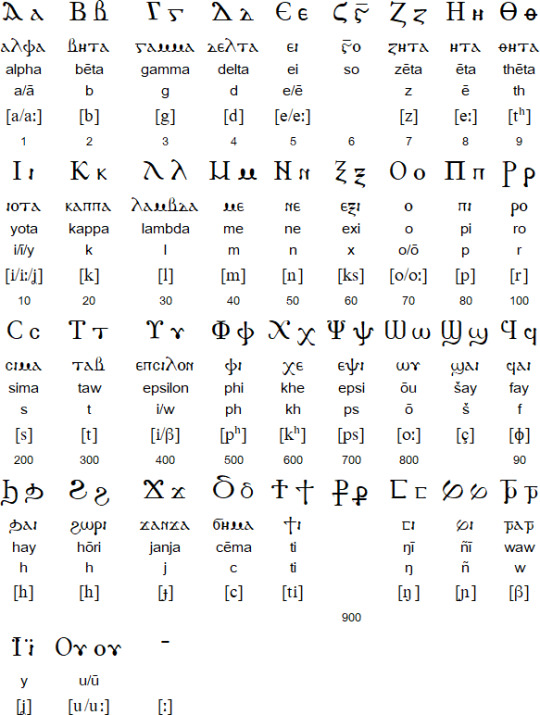
sample text (john 11:41 in old nubian):
ⲕⲧ̅ⲕⲁ ⲅⲉⲗⲅⲟ̅ⲥⲛ ⲓ̈ⲏ̅ⲥⲟⲩⲥⲓ ⲛⲁⳡⲁⲛ ⲧⲣⲓⲕⲁ, ⲇⲟⲗⲗⲉ ⲡⲟⲗⲅⲁⲣⲁ ⲡⲉⲥⲥⲛⲁ: ⲡⲁⲡⲟ, ⲥ̅ⲕⲟⲉⲗⲙ̅ⲙⲉ ⲉⲕ̅ⲕⲁ.
transliteration:
Ephouai semisi remheu nem etshōsh e axia nem dikaiosunē. Enthōou se’erehmot gnōmē nem sunēdēsis ouoh empenthreuarshēt em’metrōmi hina enthōou emephrēti enesnēou.
some coptic-learning links:
copticforall.com
coptic.net pdf
so, you want to learn coptic? (about boharic coptic)
r12a - resources on how different scripts in all languages work, good resource for languages/scripts in general.
the youtube channel ilovelanguages also has a few videos on coptic, you can find the playlist here.
31 notes
·
View notes
Text
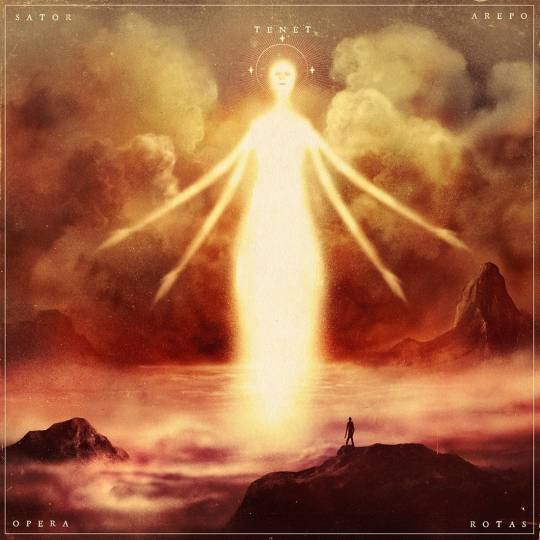

The Sator Square (or the Rotas-Sator Square, or the Templar Magic Square)
Sator square, early Latin word puzzle or cryptogram. It is the most well-known example of a lettered magic square, with 25 letters that make up a five-by-five grid of acrostic Latin palindromes. The words found in a sator square are SATOR (“sower” or “planter”), AREPO (an unknown word, possibly a name), TENET (“to hold”), OPERA (“work” or “care”), and ROTAS (“wheels”). These words are often arranged in this order, but examples have also been found beginning with ROTAS and ending with SATOR; this variant is called a rotas square.
When the five words of a sator square are read horizontally, vertically, forward, in reverse, from bottom to top, or from top to bottom, they form a sentence: sator arepo tenet opera rotas. This sentence has been translated in numerous ways, with the most commonly cited being “The sower, Arepo, works (or holds) the wheels with care.” If read boustrophedon (Greek: “to turn like oxen”; zigzag) with the central word repeating, it can be read as sator opera tenet, tenet opera sator, which has been translated as “as you sow, so you shall reap” and, with a more religious bent, “the Creator preserves his works.” Such a reading has the advantage of eliminating the obscure AREPO, which occurs nowhere else in Latin. (Few of these readings apply to the rotas square.)
The oldest complete example of this cryptogram was a rotas square found in the ruins of Pompeii in 1936. This finding, carved into a column of Pompeii’s Palestra Grande, can be dated to before 62 CE, when an earthquake destroyed the structure. (A fragmentary rotas square was found at Pompeii in 1925.) Other rotas squares have been found throughout the Roman world, from Manchester, England, to the border city of Dura-Europos (now in Syria).
After the fall of Rome and the spread of Christianity throughout Europe, the rotas square was supplanted by the sator square, possibly because the square then began with sator (“sower”), referring to the parable of the sower in Matthew 13. Another Christian connotation was that the grid’s middle word, both vertically and horizontally, is always TENET, which can be read as the two arms of a hidden cross.
The sator square’s origin as a Latin puzzle became increasingly irrelevant as the symbol took on magical properties in European folklore. In the 12th century it could be found in medical books, often as a cure for rabies and fever. Sufferers were advised to carve the square’s words into the crusts of bread before ingesting it. The sator square was also often used as a charm for good fortune in medieval times. In the centuries following, it was adopted as a ward against fires; it was inscribed on the walls of German buildings to prevent their destruction. Sator squares accompanied European settlers to the Western Hemisphere, proliferating throughout North and South America in the 18th and 19th centuries. In the Allegheny and northern Appalachian mountains, German settlers continued to use sator squares as magic cures and prophylactics into the 20th century.
Beginning in the 19th century, Christian thinkers and puzzle enthusiasts tried to decode possible hidden meanings in the sator square. Perhaps the most popular was the Pater Noster theory, which finds the Latin name of the Lord’s Prayer, Pater Noster, written twice in cross form as well as four residual letters (two each of the letters a and o), which can be read as alpha and omega, the first and last letters of the Greek alphabet and how God identifies himself in the Book of Revelation. Independently proposed in the mid-1920s by three separate authors, the Pater Noster theory fell into disfavour with the discovery of the Pompeii rotas squares. Some academics have found a basis for the square’s origin as a Jewish symbol, pointing to the Hebrew letter tau as the central symbol rather than the cross. They also point to the large population of Jews who settled in Pompeii prior to and during the 1st century. Another theory places the square’s origins in Pythagoreanism and Stoicism. Others have argued it is a gnostic symbol developed from Egyptian words and imagery. Many such arguments hinge on tenuous theories about the meaning of AREPO, and no theory of the square’s origins has been widely accepted. It has even been noted that another magic square (ROMA-OLIM-MILO-AMOR), which does not form a sentence, was found at Pompeii, and, thus, the 1st-century Romans possibly just found magic squares to be fun.
52 notes
·
View notes
Text
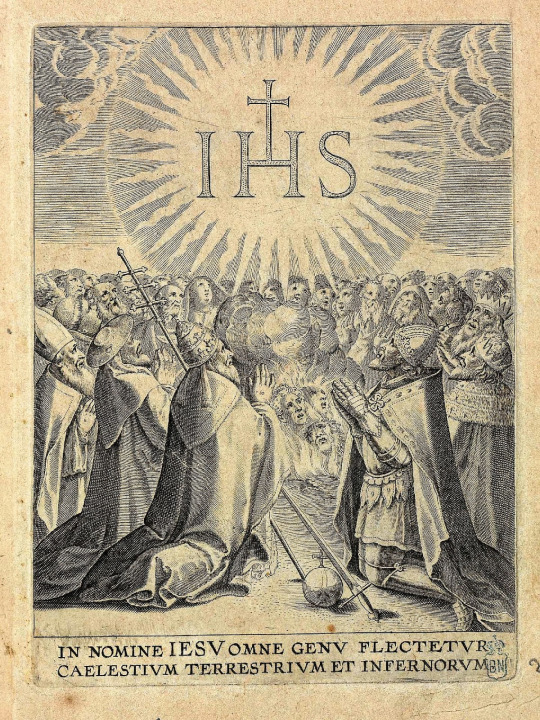
THE DESCRIPTION OF THE HOLY NAME OF JESUS The Name Above All Names Feast Day: January 3
"Praised be Jesus Christ!" -Enchiridion Indulgentiarum
In connection with the circumcision and the naming of the Holy Child on the first of January, the Catholic faithful celebrate the feast of the Holy Name of Jesus.
Jesus is a Hebrew name which means, 'God Saves.'
In the Gospel of Luke, the archangel Gabriel revealed the holy name to Mary, when he announced: 'You will conceive in your womb and bear a son, and you shall name him Jesus.'
In the Acts of the Apostles, in order to be saved, we must believe in the name of Jesus, as the apostle Peter said: 'There is no other name under heaven given to men by which we must be saved.'
For this reason, all liturgical prayers conclude with the words: 'Through Our Lord Jesus Christ.'
Perhaps the greatest promoter of the Holy Name of Jesus was St. Bernardine of Siena, who coined the Latin Christogram, 'IHS', which stands for Iesus Hominum Salvator, which means 'Jesus, savior of men.'
At the end of his sermons, he usually displayed the IHS on a tablet in gold letters, and would ask the faithful to kneel in adoration. The devotion to the Holy Name became so popular, that the IHS was inscribed in churches, sacred vestments, and on the Eucharistic bread.
16 notes
·
View notes
Note
Do you celebrate Palm Sunday?
I had to look this up and I figured out what it is xD Ishtar Sun day!
The original pagan holiday celebrated the descent and resurrection of the goddess Ishtar, or Inanna.
"The Easter story comes from the Sumerian legend of Damuzi (Tammuz) and his wife Inanna (Ishtar), an epic myth called “The Descent of Inanna” found inscribed on cuneiform clay tablets dating back to 2100 BC. When Tammuz dies, Ishtar is grief–stricken and follows him to the underworld. In the underworld, she enters through seven gates, and her worldly attire is removed. "Naked and bowed low" she is judged, killed, and then hung on display. In her absence, the earth loses its fertility, crops cease to grow and animals stop reproducing. Unless something is done, all life on earth will end.
After Inanna has been missing for three days her assistant goes to other gods for help. Finally one of them Enki, creates two creatures who carry the plant of life and water of life down to the Underworld, sprinkling them on Inanna and Damuzi, resurrecting them, and giving them the power to return to the earth as the light of the sun for six months. After the six months are up, Tammuz returns to the underworld of the dead, remaining there for another six months, and Ishtar pursues him, prompting the water god to rescue them both. Thus were the cycles of winter death and spring life." - Source
That makes more sense, all original holidays celebrated the circle of light and darkness that we go trough each year with the movements of the Earth in relation to the Sun. I love how the holidays created stories around something that is very tangible and observable every year! Christianity is pretending that all of that stuff outside isn't even that important and instead we should focus on this one dude. And it was a woman who was originally resurrected - later they found out that in order to create jesus' tomb, they tore down Ishtar's temple. Vile and disrespectful. And there's more:
"Easter as a Celebration of the Goddess of Spring
A related perspective is that, rather than being a representation of the story of Ishtar, Easter was originally a celebration of Eostre, goddess of Spring, otherwise known as Ostara, Austra, and Eastre. One of the most revered aspects of Ostara for both ancient and modern observers is a spirit of renewal.
Celebrated at Spring Equinox on March 21, Ostara marks the day when light is equal to darkness, and will continue to grow. As the bringer of light after a long dark winter, the goddess was often depicted with the hare, an animal that represents the arrival of spring as well as the fertility of the season.
According to Jacob Grimm’s Deutsche Mythologie, the idea of resurrection was ingrained within the celebration of Ostara: “Ostara, Eástre seems therefore to have been the divinity of the radiant dawn, of upspringing light, a spectacle that brings joy and blessing, whose meaning could be easily adapted by the resurrection-day of the christian’s God.”
Most analyses of the origin of the word ‘Easter’ agree that it was named after Eostre, an ancient word meaning ��spring’, though many European languages use one form or another of the Latin name for Easter, Pascha, which is derived from the Hebrew Pesach, meaning Passover."
That's two female goddesses they conveniently attempted to replace with one male :( Women own the spring and the power of resurrection, as we own the power of birth as well!
Wish I knew in detail what the pagan holidays looked like and how they were celebrated, I'd love to get into that.
10 notes
·
View notes
Text

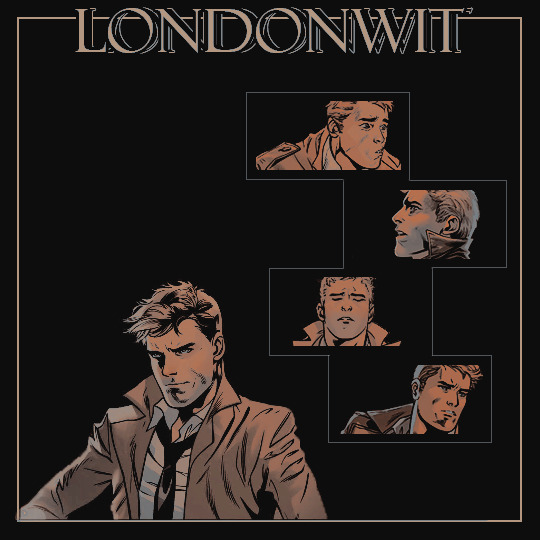
❝ let's take a walk on the d a r k s i d e then. ❞
« jack mullarkey, 30, he/him, dc comics » ∙∙ loading case file for john constantine. known aliases, if any: the hellblazer. current location: new york, new york. current occupation: occult detective. he is known to be quick-witted and selfish, so proceed with caution. their current alliance: civilian. penned by ree. ©
GENERAL DETAILS.
full name: john thomas constantine. nickname(s): johnny, conjob. name meaning: "god is gracious." age: thirty. date of birth: may 10, 1992. place of birth: liverpool, england. ethnicity: white. gender: cis man. pronouns: he/him/his. sexual orientation: bisexual. romantic orientation: biromantic. religion: unaffiliated. occupation: occult detective. education level: general certificate of education (gce). living arrangements: bounces from one place to another; was homeless for several months when he was 16 after being kicked out of his childhood home by his father. speaking voice and accent: british. spoken languages: english, latin, ancient greek, hebrew, sanskrit, ect.
PHYSICAL APPEARANCE, ETC.
faceclaim: jack mullarkey. hair color and style: blonde, clean cut. eye color: blue. height: 6'0". weight: 158 lbs. body and build: lanky, somewhat muscular. tattoos: several incantations of varying languages inscribed on his forearms, similar to the tattoos he has in the injustice comics. piercings: helix piercing in both ears, yet they've mostly closed up. clothing style: typically formal wear with a tie and trenchcoat. distinguishing characteristics: dimpled chin and piercing blue eyes. signature scent: silk cut cigarettes.
HEALTH.
mental disorder(s): suffers from depression and post-traumatic stress disorder, as well as brief instances of psychosis following the incident in newcastle when he damned a young girl’s soul to hell by accident. physical disorder(s): lung and cardiovascular complications due to his chain smoking. allergies: cats. sleeping habits: often experiences insomnia and has difficulty falling asleep. he also just stays up until ungodly hours. eating habits: a lot of instant noodles and hot pockets. sociability: he’s rather sociable unless he’s going through a rough time. it’s others who’d prefer not to associate with him given his track record of dead friends and family members. addictions: nicotine. drug abuse: in his early twenties, he was on antidepressants and prescribed olanzapine by his doctors at ravenscar psychiatric institute, where he was a patient for two years. alcohol use: will go on a bender every once in a blue moon but usually sticks to a glass of whiskey (or several) each night.
PERSONALITY.
label(s): the con artist, the devil’s advocate, the bibliophile, the karma houdini, the narcissist, the hellion, the addict, the deadpan snarker, the anti-hero. positive traits: charismatic, persuasive, humanistic, pragmatic, quick-witted. negative traits: cunning, selfish, arrogant, cynical, self-loathing. astrology: taurus. personality type: entp. moral alignment: chaotic neutral. hogwarts house: slytherin. element: fire. primary vice: pride. primary virtue: diligence. weather: rainstorm. color: orange/gold. music: the clash. movie: blade runner. book: the island of doctor moreau. sport: rugby. beverage: whiskey. food: bacon and eggs. animal: fox. season: autumn.
FAMILY.
mother: mary anne constantine (died in childbirth). father: thomas constantine (deceased). significant other: n/a. best friend: chas chandler. exes: zatanna zatara, oliver (ex-boyfriend), nightmare nurse, several meaningless flings. sibling(s): cheryl masters, sister (murdered by her husband), unnamed twin brother (died in the womb). children: n/a. extended family: tony masters, brother-in-law (deceased), gemma masters, niece. pet(s): n/a.
short bio: after a botched exorcism in his adolescence led to an innocent girl named astra logue being damned to hell, john has been running from the demons of his past and drowning his sorrows in a bottle of liquor, all while leaving a trail of dead bodies in his wake. a conman by trade and savvy occult detective on nights he’s not conjuring demons, john’s spent the last several years swindling the streets of london with his impressive wit and token charm.
6 notes
·
View notes
Text
NO THIS IS SO CORRECT LIKE. ok. the tanakh is very clearly meant to be a fable explaining many things, such as why the world is the way it is, why cultural preservation is important and how to do it if you are in these particular places at this particular time, the virtues and common pitfalls of man, and every punishment by god is natural disaster, or direct manmade action and fitting consequence, sometimes allegorical. everything has this sort of weight to it, that you're really reading this set of disconnected but important myths. and then. and then? the new testament comes along. this is where most biblical contradictions come from. it is straight up its own thing. i really need to reread if I'm going to talk about it in depth like this, but my initial interpretation about 3 years ago was that to accept the new testament in conjunction with the tanakh, we must accept the bible as one of a few things:
-entirely allegorical, manmade, and meant as a guidebook with no basis in reality
-god both changed his mind about a lot when living as jesus, and the people writing had very different interpretations of how to write his word than they did when inscribing the tanakh
-the new testament is just written on the basis of a completely different prophet and apostles, in a completely different time, in a completely different culture and language (koine greek vs the hebrew and aramaic of the tanakh). this is the interpretation i tend toward. personally, for me, i am coloring this through the lens of a nonbeliever, however even if you do believe in the Christian Bible, think about it! how different must the translation from source to Latin to English been between ancient Hebrew, Aramaic, and Koine Greek languages. of course they would come across very differently!
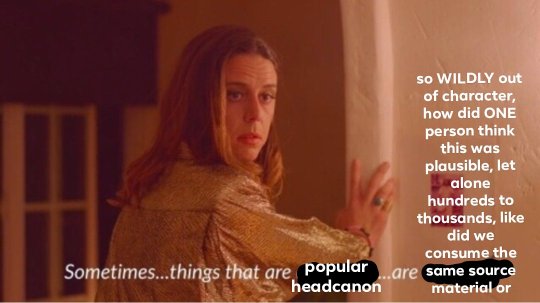
#religion#i still really want to learn hebrew to better interpret this#I'm not a believer but i think learning about historic religion as a form of anthropology is very very fun
83K notes
·
View notes
Text
The Languages of Middle-earth: Sindarin, Khuzdul and Westron

This is another article on our series of fictional languages created by J.R.R Tolkien. On our blog, you can also find an in-depth analysis of the Quenya language and the Black Speech of Mordor, as well as an article scratching the surface of the most popular languages of Middle-Earth in general. This time we’ll dive deeper into the Sindarin language, find out more about the secret Dwarfish tongue called Khuzdul and learn the history of the common language of Middle-earth called Westron. So, let’s see what we’ll learn in this article: What is the Sindarin language? Who spoke it? What is Khuzdul? Why was the language kept secret? What is Westron? Who spoke it in Middle-earth? Is it possible to learn any of these languages? So, without further ado, let’s start the journey! Sindarin: the stereotypical “Elvish” language Sindarin is the language most commonly associated with the Elves. It is also the most widely spoken Elvish tongue in The Lord of the Rings. FAQ: What is Sindarin? Sindarin is a language most commonly associated with the Elves of Middle Earth. Tolkien created it in 1944, wanting it to sound Welsh-like. Sindarin was a lingua franca among Elves and their friends, and when Frodo asks how to say 'friend' in Elvish, he actually asks about Sindarin. How to learn Sindarin? You can easily find Sindarin translators, websites dedicated to this language, and online courses. After learning the basics, you can turn to the Lord of the Rings books, look for Sindarin texts, and try to understand them. What language is Sindarin based on? Sindarin was supposed to be a Welsh-type language, which is related to Quenya the same way that Welsh was related to Latin. What is Khuzdul? Khuzdul is the secret language of the Dwarves. There's not much Khuzdul vocabulary to be found. The language was meant to be harsh in sound, which stood in opposition to the melodic and gentle Elvish languages. How to learn Khuzdul? You can easily find some online resources to learn Khuzdul, but there may not be much to learn, as Tolkien didn't create much vocabulary in this language. What language is Khuzdul based on? The main source of inspiration for Khuzdul was the Hebrew language. What is Westron? Westron was the language of the Dúnedain of Middle-earth, but by the end of the Third Age, it was used by the vast majority of creatures living in the north-western part of Middle Earth. How to learn Westron? You can easily find online resources for learning the Westron language. You can also get in touch with the Lord of the Rings fandom to learn any language created by Tolkien. What language is Westron based on? Westron is based on another Middle-Earth language called Adûnaic, as it derived from it. It is also somewhat similar to Khuzdul but softer, thanks to Sindarin influences. The origins of Sindarin Tolkien created Sindarin around 1944. He wanted it to be a Welsh-type language that was related to Quenya the same way Welsh was related to Latin. The author of The Lord of the Rings also wrote many pieces of work in Sindarin, as he very much wanted to give it a feel of a natural language. Nevertheless, Tolkien did not provide a detailed description of this tongue in any of his books. In the 1970s many Tolkien fans started writing poems, texts, phrases, names, and even tattoos in Sindarin. Despite the fact that the total corpus of its vocabulary consisted of only a few hundred words, the fans made this fictional tongue flourish. Note that Tolkien didn’t want his languages to be complete enough to make a conversation. Therefore, newly created texts in Sindarin, with the dialogues from The Lord of the Rings movies included, often use new words and novel grammatical structures. Sindarin in the history of Middle Earth Within the realm of Middle-earth, in the Second Age, Sindarin was a lingua franca among Elves and their friends. That’s why the West Gate of Moria was inscribed in this tongue. When Frodo ask what’s the Elvish word for friend, he means what’s Sindarin word for friend. However, the Third Age saw the rise of the Westron language, which replaced Sindarin as the universal tongue of Middle-earth. Nevertheless, Westron was heavily influenced by its Elvish predecessor. In the Third Age, however, Sindarin was still spoken by some noble inhabitants of Minas Tirith. What’s more, Aragorn, who was raised among the Elves in Rivendell, could speak it fluently. Let’s learn some Sindarin vocabulary There were around 25 000 published words in Sindarin in 2008. Let’s learn some of them from the below table: Sindarin English amar earth aur day dû night naur fire menel sky daer great benn male bess female nen water corf ring fae soul, spirit Let’s read some Sindarin The Lord of the Rings book features a long poem written in the Sindarin language. It’s called A Elbereth Gilthoniel, and it’s an Elvish hymn to Varda. Varda, or Elbereth, was one of the angelic creatures serving Eru Ilúvatar, the equivalent of the Christian God. The poem is written in iambic tetrameters and has been compared to the Roman Catholic hymns to Mary, mother of Jesus. Unfortunately, The Lord of the Rings doesn’t include any translation of the piece. It is, however, described in the books in the following way: “The sweet syllables of the elvish song fell like clear jewels of blended word and melody. 'It is a song to Elbereth', said Bilbo" (The Lord of the Rings, J.R.R. Tolkien) There’s also a hint on the meaning later in the book: "Good night! I'll take a walk, I think, and look at the stars of Elbereth in the garden. Sleep well!" (The Lord of the Rings, J.R.R. Tolkien) Luckily, The Road Goes On, the 1967 collection of sheet music written by a British composer Donald Swann to accompany the poetry from Middle-earth, includes the translation of the poem. Here’s the poem in Sindarin: A Elbereth Gilthoniel silivren penna míriel o menel aglar elenath! Na-chaered palan-díriel o galadhremmin ennorath, Fanuilos, le linnathon Everwhite, nef aear, sí nef aearon! A Elbereth Gilthoniel o menel palan-diriel, le nallon sí di'nguruthos! A tiro nin, Fanuilos! And here’s the English translation: O Elbereth Starkindler (white) glittering slants down sparkling like jewels from firmament glory the star-host! To-remote distance far-having gazed from tree-tangled middle-lands, Fanuilos, to thee I will chant on this side of ocean, here on this side of the Great Ocean! That would be it when it comes to the Sindarin language. Later in the article, we will see where you can learn to speak it. Khuzdul: the secret language of Dwarves J.R.R. Tolkien started developing Khuzdul before the publication of The Hobbit in 1937. Some Khuzdul names even appeared in the earlier versions of Silmarillion. Hebrew was the main source of inspiration for this Dwarven tongue. Tolkien also pointed out certain parallels between Jews and dwarfs. Both were locals and aliens in their own country. What do we know about Khuzdul Unfortunately, there’s not much Khuzdul vocabulary to be found. Nevertheless, Tolkien claimed that he developed this language to some degree, including phonology and grammar. The syllable structure of Khuzdul made this tongue harsh, according to the Elves, who found its sound ugly. As a matter of fact, Tolkien himself stated that the Dwarvish language was cacophonic rather than beautiful. Khuzdul was given to Dwarves by Aulë — a divine smith and one of the immortal beings that participated in the creation of Arda (the equivalent of the real-world Earth). And, as Dwarves showed deep respect for Aulë, little changes were made to Khuzdul over time. Dwarves used the Cirith, a script created by Tolkien and based on the real-world runes, to write down Khuzdul. Dwarves adopted the runes from the Elves and modified them to be more representative of the Khuzdul language. Khuzdul writing system They would eventually use two different methods of writing. One of them was developed by the inhabitants of Moria in Khazad-dûm and the second came from Erebor — The Lonely Mountain known from The Hobbit. Let’s take a look at a Dwarfish battle cry written both in Moria and Erebor versions of Cirith. Moria: (Source: Wikipedia) and the Romanized version: baruk khazâd khazâd ʻaimênu Erebor: (Source: Wikipedia) and the Romanized version: baruk khazâd khazâd aimênu The history of Khuzdul When it comes to the internal history of this language, little is known about Khuzdul. It’s mainly because Dwarves kept it secret. They believed that this language was reserved only for them, so they reluctantly taught it to other races. Also, they made it harsh and difficult to use, so that it would be very hard to learn and speak. As a matter of fact, Dwarves used other languages to communicate with outsiders (for instance, Westron). They used Khuzdul only to speak between themselves. The highest level of secrecy was reserved for their real names, which Dwarves considered very intimate. The names of the Dwarves we all know from the books and movies are all “outer-names” reserved for other races. However, because of a close friendship with some humans of Middle-earth, they were also using Khuzdul among themselves in their presence. Let’s learn some vocabulary right now: Khuzdul English aglâb language duban valley gundu underground hall Khuzd Dwarf uzn shadow zigil silver (colour) kheled glass felak a tool for cutting stone uzbad lord shathûr could(s) Let’s read some Khuzdul Here are 3 phrases in Khuzdul that can be found in some of J.R.R. Tolkien’s works. Let’s see what they mean in English: Balin Fundinul Uzbad Khazaddûmu — Balin, Son of Fundin, Lord of Moria baruk Khazâd — axes of the Dwarves Khazâd ai-mênu — the Dwarves are upon you! We can now see that the battle cry we examined earlier on can be roughly understood as “Axes of Dwarves, the Dwarves are upon you!”. That would be it when it comes to Khuzdul. Stay with us until the end to see where can you learn some of this tongue. Westron: the common tongue of Middle-earth Originally, Westron was the language of the Dúnedain of Middle-earth, but by the end of the Third Age, it was used by the majority of creatures of the north-western region of this fictional world. The Westron language emerged from Adûnaic — the language of Númenorians. The Men of Númenor brought it to Middle-earth when they established trade outposts there in the Second Age. Westron emerged as a creole tongue after Adûnaic fused with the speech of the Men of Twilight. Note: There were 3 kinds of men living in the Middle-earth in the Third Age. They were: High Men — Gondorians, noble descendents of Númenor; Men of Darkness — Haradrim, Easterlings, Variags, Black Númenorians, Corsairs of Umbar, Half-Trolls, who served Sauron; Men of Twilight or Middle Men — other Men in Middle-earth who descended from Edain, ancient Men who fought alongside Elves in the war with Morgoth. The term ‘Men of Twilight’ reflects the attitude of Gondorians towards them — they thought that Middle Men were not their enemies, but were not noble enough to be High Men as well. History of Westron After the fall of Númenor (which may be the Middle-earth equivalent of both the Flood Myth and the destruction of Sodom and Gomorrah) the Númenorians abandoned Adûnaic who was then spoken by the Men of Twilight. Having become a harsh language with a Khuzdul influence, Westron softened thanks to the influences from such languages as Sindarin. In the Third Age, Westron was spoken by almost all Men of Middle-earth, as well as other creatures, including Hobbits (however, they developed their own dialect of Westron called Hobbitish). This common tongue of Middle-earth was also used by Dwarves as their public language. When it comes to the Men of Middle-earth, Westron was also adopted by the shape-shifting creature called Beorn, as well as the inhabitants of the town by the lake near the Lonely Mountain. The examples of humans who didn’t use Westron were Rohirrim, The Drúedain, and the Men of Dunland. Westron in the books Westron was also the language spoken and understood by the protagonists of both The Hobbit and The Lord of the Rings. Therefore, it is a common misconception that Westron was simply English. As a matter of fact, Tolkien provided its readers with the “English translation” of this common tongue of Middle-earth. The character names, such as Frodo, Sam and Pippin, were not their actual names. Their Westron equivalents were Maura, Ban, and Razar. Let’s look at the below table to learn more Westron vocabulary: Westron English Karningul Rivendell Labin-nec Bag End kuduk hobbit banakil halfling branda borderland Branda-nîn Brandywine (the name of the river) Bilba Labingi Bilbo Baggins Incánus Gandalf orka orc narag dwarf You can see that it resembles Khuzdul, but it way softer thanks to the influences of the Sindarin language. So, that would be it for Westron. Let’s now have a look at the reliable sources for learning the languages of Middle-earth from. Where to learn Sindarin, Khuzdul and Westron To be honest, the best source of information on the above languages can be found in The Return of the King appendices. However, you can learn quite a lot about Tolkien’s languages from The Elfish Linguistic Fellowship (abbreviated E.L.F). It is an international organization that examines the fictional languages created by J.R.R. Tolkien. They release two printed journals: Vinyar Tengwar and Parma Eldalamberon. They also have their own online journal called Tengwestië. What’s more, you can find more vocabulary of the above languages here, here and here. Sindarin, Khuzdul and Westron: Conclusion Despite the fact that The Lord of the Rings was published over half a century ago, the work of J.R.R. Tolkien is still as popular as it was years ago, maybe now even more so. We didn’t hear Tolkien’s languages in Peter Jackson’s adaptation of the book very often, but, luckily, there are a lot of materials on the Middle-earth speeches written by the author himself. And if you have a passion for learning languages, but not necessarily time and motivation, be sure to check our store. With our newest standalone device, Vasco Translator V4, you have 108 languages in your pocket! Maybe someday even Sindarin, Khuzdul and Westron too… In a nutshell Sindarin is the Elvish language most associated with The Lord of the Rings, and was developed by Tolkien around 1944. It was a creole tongue, heavily influenced by Welsh and Quenya, and was the common language of Middle-earth in the Second Age. Khuzdul is the secret language of the dwarves, created by Tolkien and based on Hebrew. Dwarves kept it secret and used it only among themselves, using Westron as their public language. Westron is a creole language resulting from the fusion of Adûnaic and the speech of Men of Twilight. It was used by almost all creatures of the north-western region of Middle-earth in the Third Age, and was the language spoken and understood by all protagonists of The Hobbit and The Lord of the Rings. To learn more about Sindarin, Khuzdul and Westron, one can check The Elfish Linguistic Fellowship's online journal, Tengwestië, as well as other sources. Read the full article
0 notes
Text
"Merkabah mysticism, or ma'aseh merkavah, was the name given in Mishnah Hagigah, 2:1, to the first chapter of Ezekiel . The term was used by the rabbis to designate the complex of speculations, homilies, and visions connected with the Throne of Glory and the chariot (merkavah) which bears it and all that is embodied in this divine world. The term, which does not appear in Ezekiel, is derived from I Chronicles 28:18 and is first found with the meaning of Merkabah mysticism at the end of Ecclesiasticus 49:8: "Ezekiel saw a vision, and described the different orders of the chariot" . The Hebrew expression zanei merkavah should possibly be interpreted as the different sights of the vision of the chariot in Ezekiel , chapters 1, 8, and 10 or as the different parts of the chariot, which later came to be called "the chambers of the chariot" (hadrei merkavah). It has been suggested that the text be corrected to razei merkilvah ("secrets of the chariot"). The divine chariot also engrossed the Qumran sect ; one fragment speaks of the angels praising "the pattern of the Throne of the chariot"
----
"In the history of the Kabbalah a different contemplation preceded this one: the contemplative vision of the Merkabah, for which the ancient Merkabah mystics of the tannaitic and amoraitic period strove, and which was described in the Heikhalot Rabbati of the heikhalot literature. Here the reference is to an actual vision of the world of the chariot which reveals itself before the eyes of the visionary. Therefore the term histakkelut is used here in the exact sense of the Latin term contemplatio or the Greek theoria. The contemplation of the Merkabah mystics, in the first period of Jewish mysticism, provided the key, in their opinion, to a correct understanding of the heavenly beings in the heavenly chariot. This contemplation could also be achieved by way of preparatory stages which would train those who "descend to the Merkabah" to grasp the vision and pass on from one thing to another without being endangered by the audacity of their assault on the higher world. Even at this stage, the vision of the Merkabah is bound up with immunization of the mystic's senses against absorption of external impressions and concentration through an inward vision.
Image: Diagram of the Hekhalot, showing at the top two concentric circles with a smaller circle beneath; the upper circle is divided into four parts, inscribed רקיע and ערבות ; the 'walls' of the Hekhalot are described in the outer circle; the inner circle represents the throne, composed of precious stones:, ברקת גחלית, מרגלית, ספיר"
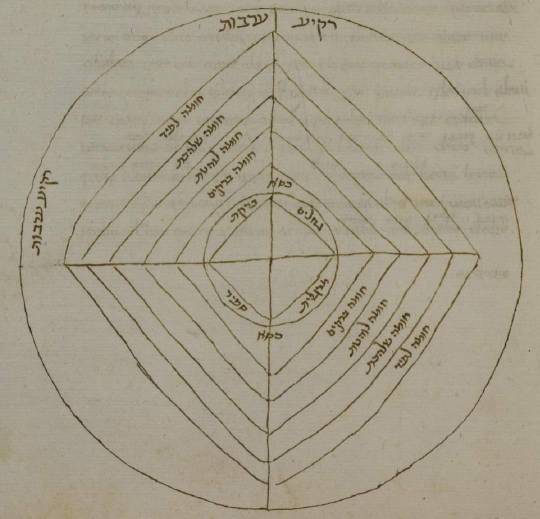
0 notes
Text
Yosef Yerushalmi tells the story of his discovery, in the Freud Archives in Washington DC, of the family Bible that Freud's father Jakob first inscribed, in Hebrew, on the occasion of Sigmund Freud's circumcision. Thirty-five years later, the elder Freud had the volume re-bound in leather, and he added a dedication to his son, by hand and in Hebrew, composed as a melitzah—a traditional genre in Hebrew letters consisting of an arrangement of textual bits drawn from the Bible and other Jewish sources. Yerushalmi appears to believe—though he does not insist—that this dedication offers strong evidence of Freud's ability to read and understand Hebrew, Freud's own statements to the contrary notwithstanding (70-74). According to Jacques Derrida, Yerushalmi wants to make Freud "confess" this competence: "Because Freud . . . must have known, from a young age, how to read the dedication. He ought, in consequence, to have confessed belonging, thus making his Hebrew culture public" (38; emphasis added). From the Latin confiteri, the verb "confess," indeed, can mean not only to admit the commission of a crime or fault, but also to reveal or disclose, and "to reveal oneself as" (Oxford Latin 401). In English, French, and other modern languages, confession also of course came to refer to a declaration of belief, a profession of faith—as well, for example, as a particular religion, as in the phrase der jüdischen Konfession. This confession by Freud, however, this act of self-disclosure and avowal of "Hebrew culture," is nowhere to be found. If it ever existed as a physical record beyond the realm of induction and suggestion, then it is missing. Unless, of course—and this is precisely Yerushalmi's point—it comes to us, transposed, as Moses and Monotheism.
Yerushalmi calls Freud's writing of Moses an act of "deferred obedience" to a paternal "mandate" (77, 74). The melitzah written by Jakob Freud in 1896 directed Sigmund to return to the book and to reengage his Jewish origins. At a distance of thirty-eight years, the son obeyed the father by radically rewriting the history that constitutes and preserves the Jews as a people. [...]
If Swann is thus like Sigmund Freud, a Jew whose Judaism may be "terminated," but whose Jewishness appears "interminable," he is also strangely like Jakob. For he is the one who implicitly also issues the mandate, to his daughter Gilberte: remember your Jewish father. A mandate like his is a variant, to be sure, of what Yerushalmi has called the "injunction to remember"—regarded "[o]nly in Israel and nowhere else … as a religious imperative to an entire people" (Zakhor 9).
—L. Scott Lerner, "The Subversive Obedience of Proust and Freud," Vol. 51, No. 2, Modernism's Jews/Jewish Modernisms (Summer 2005).
4 notes
·
View notes
Quote
No American has to fear Adriaan Koerbagh’s fate, no matter how unpopular his or her opinions. Still, Buruma argues, “liberal thinking is being challenged from many sides where ideologies are increasingly entrenched, by bigoted reactionaries as well as by progressives who believe there can be no deviation from their chosen paths to justice.” And it is certainly true that, in the age of social media, informal pressure to toe a certain line can be as effective as legal threats. Offending the wrong people, even for a moment, can blow up the career of anyone from a Y.A. novelist to an Ivy League president. In calling Spinoza a “messiah,” Buruma follows Heinrich Heine, the nineteenth-century German Jewish poet, who compared the philosopher to “his divine cousin, Jesus Christ. Like him, he suffered for his teachings. Like him, he wore the crown of thorns.” According to Jonathan Israel, a historian whose encyclopedic biography “Spinoza, Life and Legend” came out last year, “No other personage of his era came even close to being so decried, denounced and condemned in weighty texts of exhaustive length, over so long a span of time, in Latin, Dutch, French, English, German, Spanish, Portuguese, Hebrew, and other languages.��� Like deconstruction or critical race theory, “Spinozism” became a popular target for many a moralist who could not have said exactly what it meant. Yet, although Spinoza was certainly a champion of political and intellectual freedom, he had no interest in being a martyr for them, and, if his life teaches anything about thinking in dangerous times, it is how prudence and boldness can go hand in hand. Not for nothing did he wear a ring inscribed with the Latin word “Caute”: “Be cautious.”
Baruch Spinoza and the Art of Thinking in Dangerous Times
0 notes
Text
Metal detectorist finds medieval gold brooch with supernatural inscriptions

A metal detectorist has discovered a medieval gold brooch with a series of Latin and Hebrew inscriptions. The artifact, found in Wiltshire in the U.K., may have mixed religion and magic in an attempt to give its user protection against illness or supernatural events.
The Latin inscriptions translate to "Hail Mary full of grace the lord/ is with thee/ blessed art thou amongst women/ and blessed is the fruit of thy womb. Amen." The Hebrew initials for "AGLA" are also inscribed on the brooch and represent Hebrew words that mean "Thou art mighty forever, O Lord."
The gold brooch dates to sometime between A.D. 1150 and 1400 and may have been used in an attempt to prevent fever, according to a brief report on the brooch published online by the Portable Antiquities Scheme (PAS) and written by Sophie Hawke, a finds liaison officer for PAS. Read more.
397 notes
·
View notes
Photo

Angels with Attributes of the Passion, the Superscription from the Cross, Simon Vouet, 1627, Minneapolis Institute of Art: Paintings
Part of a series of 12 paintings by Vouet of angels holding symbols of the Passion; another is 69.36.1 (angel holding vessel and towel for washing the hands of Pontius Pilate) This angel holds a tablet inscribed “Jesus of Nazareth, King of the Jews” in Hebrew, Greek, and Latin was placed on the cross, above Jesus. The painting belongs to a series of twelve angels carrying symbols of Christ’s Passion—the events associated with Jesus Christ’s suffering and death--which were painted for a private patron in Rome, Ascanio Filomarino, later appointed a cardinal of the Church and archbishop of Naples. Simon Vouet was one of the most important painters of his generation in France, ultimately serving as First Painter to King Louis XIII. From 1612 to 1627, he worked in Rome. These angels was among the last works he painted there, completed just months before his return to France. In Paris, he helped introduce French artists to the Baroque style: high drama, rich color, intense light, and dark shadows. /// We are grateful to Sebastian Schütze for clarifying the provenance of this painting. Size: 41 1/16 x 30 15/16 in. (104.3 x 78.58 cm) (canvas) Medium: Oil on canvas
https://collections.artsmia.org/art/1734/
88 notes
·
View notes
Photo

The Yale University coat of arms is the primary emblem of Yale University. It has a field of the color Yale Blue with an open book and the Hebrew words Urim and Thummim inscribed upon it in Hebrew letters. Below the shield on a scroll appears Yale's official motto, Lux et Veritas (Latin for "Light and Truth"). (via Wikipedia)
24 notes
·
View notes
Photo

An Explanation of the Traditional Russian Orthodox Three-bar Cross - Old Rite
The symbolism of the "complete" Cross (much of which is contained in the Old Rite Russian prosphora seal and on metal and wood icons) is quite complex. Since the OId Rite tradition of the Russian Orthodox Church is much richer than the New Rite Church in its use of symbolism to teach the faithful, this article should be of benefit to those unfamiliar with this tradition.
Through the Cross came our Salvation. We are constantly reminded that Christ died for us when we see the Image of the Cross (depicting the crucified Lord), and we are reminded that He rose from the dead when we behold the Image of Christ "Not made by hands" (Slavonic: Нерукутвореному образъ) on the towel (depicting the Lord risen frem the dead).
Worshipping the crucified Lord are two flying angels, with the inscription between them: "Angels of the Lord" (in Slavonic: Ангели Господни). In some depictions of the Cross the Angels are bearing an image of the Holy Trinity, but traditions vary in allowing this; usually the Angels are simply holding towels, indicating their position as messengers who serve the Lord and who wait on Him.
The top bar of the Cross is the title-board which Pilate ordered to be hung in mockery over Christ's head. On this board was inscribed: "Jesus of Nazareth, King of the Jews" in Hebrew, Greek and Latin (abbreviated to the Greek initials 'INBI', or the Latin initials 'INRI' in the Western tradition). This has been replaced with the Christian inscription: "King of Glory" (Slavonic: Царь славы), placed below the knees of the angels. [Note that while the use of the inscription 'І.Н.Ц.І.' does not usually appear in the Russian tradition, examples of its occurrence are occasionally found on newer Russian Crosses.] On the title-board is inscribed the initials 'IC XC', being the first and last letters of Christ's name in Greek (Greek: Iisous Khristos; Old Rite Slavonic: Ісоусъ Христосъ; New Rite Slavonic: Іисусъ Христосъ). In addition, just above Christ's arms we see the inscription: 'NIKA', which in Greek means: "He conquers" or "He is victorious." [Frequently, especially on the Greek and New Rite Russian prosphora seal, we see these last two inscriptions together with the simple two-barred Cross: 'IC XC NI KA', meaning: "Jesus Christ is victorious" (i.e., over death and sin). Note that in the proper Orthodox tradition the Saviour does not wear a crown of thorns (as in the Western tradition), nor is He portrayed alive on the Cross, nor in any aspect of suffering, but in a state of humble and peaceful repose, with inclined head. Also note that His feet are nailed with two nails.]
The middle bar is that on which the Lord's hands were nailed. On either top corner we see the depiction of the sun (left; in Slavonic: солнца) and the moon (right; in Slavonic: луна), for "The sun hid its light, and the moon turned to blood." (Joel 2:31) The inscription: "Son of God" (Slavonic: Сынъ Божіи) is placed on both sides of Christ's head, and below His arms we read the inscription: "We bow down before Thy Cross, O Master, and we worship Thy holy Resurrection" (in Slavonic: Кресту Твоему покломняемся Владыко, и святое воскресение Твое славимъ). The halo of Christ is inscribed with the Greek letters 'w ov', meaning: 'The Being' or 'He Who is', to remind us that Christ is the same God Who identified Himself with those words to Moses in the Old Law.
Behind the body of Christ, on either side, are a lance (which pierced Him) and a sponge (which was soaked with gall or vinegar and offered Him to drink) on a pole made of reed or cane. The lance (on the left:) is marked "К" in Slavonic; standing for "копие", while the sponge (on the right) is marked "Т", standing for: "трость" (which means: 'reed' or 'cane'). [On some Crosses one might see instead of "Т" the inscription "Г" which stands for "губка" (sponge) in Slavonic.] On the body of Christ is depicted blood and water flowing forth from His side.
The slanted bottom bar is the foot-brace. In prayers for the Ninth Hour, the Church likens the Cross to a type of balance of righteousness:
"Between two thieves Thy Cross did prove to be a balance of righteousness: wherefore one of them was dragged down to Hades by the weight of his blasphemy [the balance points downward], whereas the other was lightened of his transgressions unto the comprehension of theology [the balance points upward]. O Christ God, glory to Thee."
The city of Jerusalem is depicted in the background, for Christ was crucified outside the city walls. By the foot of the Cross are the letters: "Г Г" standing for 'Mount Golgotha' (in Slavonic: Гора Голгофы); this is the hill outside the city gates upon which Christ was crucified. Below the feet of Christ are four Slavonic letters with abbreviation marks: "М.Л.Р.Б.", meaning: "The place of the skull, where Adam was" (in Slavonic: Место лобное рай бысть). Hidden in a cave under the earth is 'the skull of Adam' (for by pious tradition it is said that Christ was crucified at preciseIy the same place where Adam was buried), identified with the letters: "Г А" (in Slavonic: глава Адамла). We are thus reminded that Adam our forefather lost Paradise through the tree from which he wrongIy partook; Christ is the new Adam, bringing us Salvation and Paradise through the tree of the Cross.
33 notes
·
View notes
Photo
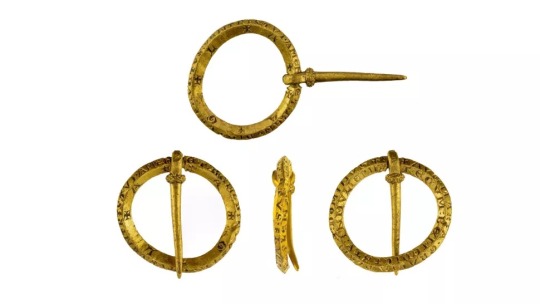
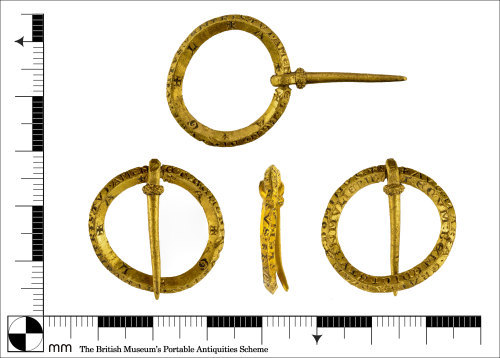
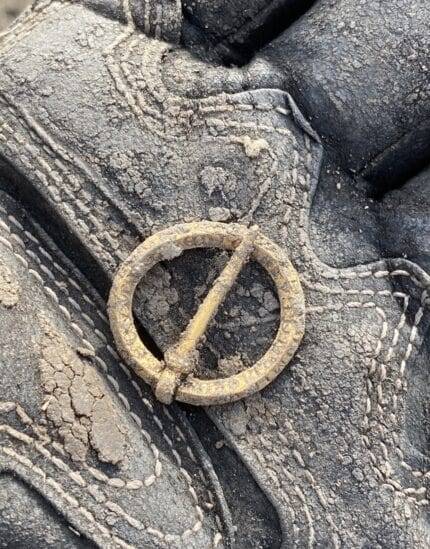
Medieval Gold Brooch with Supernatural Inscriptions Found in U.K.
A Medieval gold annular brooch with prayerful inscriptions has been discovered in the parish of Manningford in Wiltshire, in the U.K.
A medieval gold brooch with a series of Latin and Hebrew inscriptions may have mixed religion and magic in an attempt to give its user protection against illness or supernatural events.
It was dated between 1150 and 1350 A.D. and is inscribed with a Latin prayer as well as the initials of a Hebrew phrase said to have amuletic characteristics. While this type and age of inscribed brooch have been previously been discovered, this one is unique on the archaeological record because the inscription is complete, without errors (common in an age when artisans were not literate), is engraved on four sides, and includes both the prayer and the amuletic initials.
A complete Medieval gold inscribed annular brooch, dating to c. AD 1150-1400. The brooch has a slightly sub-circular frame, with a lozengiform cross-section. The frame is beveled on either side, giving four surfaces, each inscribed with part of Christian devotional prayer. The letters are inscribed in Lombardic text, with the use of cross potent to divide some of the text. Each part of the inscription reads clockwise from the pin constriction.
The inscription on three of the surfaces is the Hail Mary which all together read: + AVE. MARIA. GRACIA. PLENA: DOMINVS: + T: ECVM: BENEDICTATV: INMULIERIBV ET: BENEDI(CT)VS: FRVCTVS: VENTRIS: TVI. AMEN. (Meaning “HAIL MARY FULL OF GRACE THE LORD/ IS WITH THEE/ BLESSED ART THOU AMONGST WOMEN/ AND BLESSED IS THE FRUIT OF THY WOMB. AMEN.”) The S at the end of “MULIERIBV” is missing, not an error, but a deliberate choice because the pin attachment was in the way.
The fourth surface, the reverse inner angle, reads: + A + G + L + A +, the initials of the Hebrew phrase “Atha Gebir Leilam Adonai. (Meaning “Thou art mighty forever, O Lord.”) The AGLA initials were used in the Middle Ages as words of power to protect against illness, particularly fever, and nefarious supernatural forces.
The brooch was discovered by metal detectorist William Nordhoff in March of last year in a freshly plowed field in Pewsey Vale.
At a coroner’s inquest last month, it was proclaimed treasure. The next step is valuation, after which a local museum, in this case, likely the Salisbury and South Wiltshire Museum, will have the opportunity to acquire the brooch for the assessed market value.
By Leman Altuntaş.
#Medieval Gold Brooch with Supernatural Inscriptions Found in U.K.#treasure#gold#jewelry#ancient artifacts#art#artist#art work#art news#metal detector#archeology#archeolgst#history#history news#ancient history#ancient culture#ancient civilizations
9 notes
·
View notes